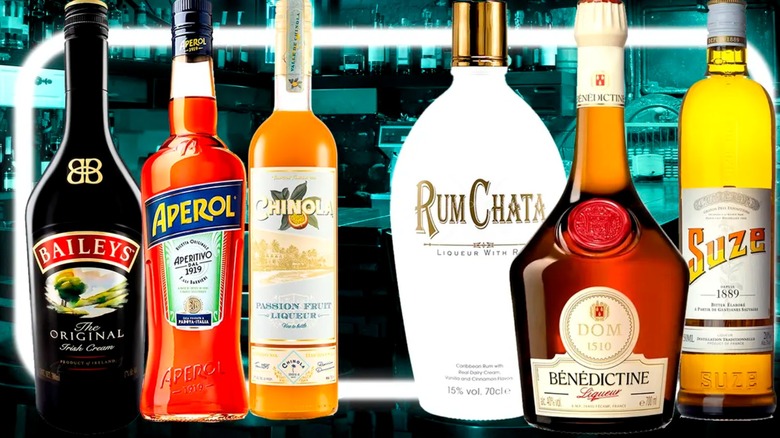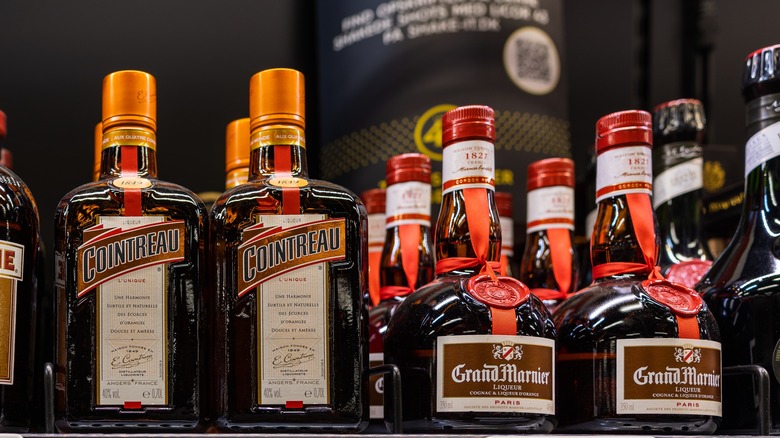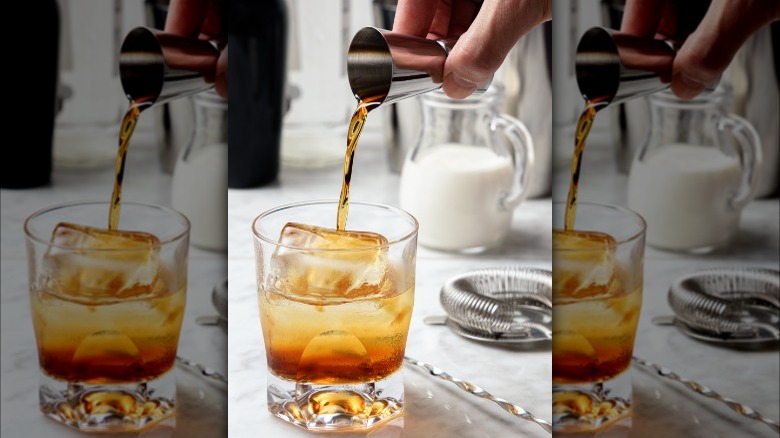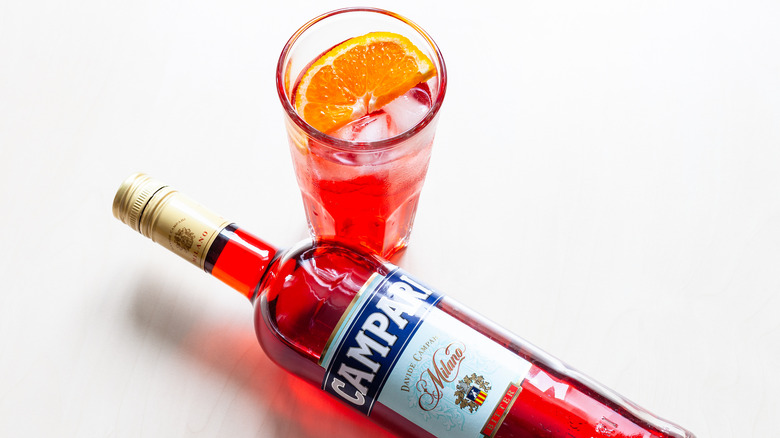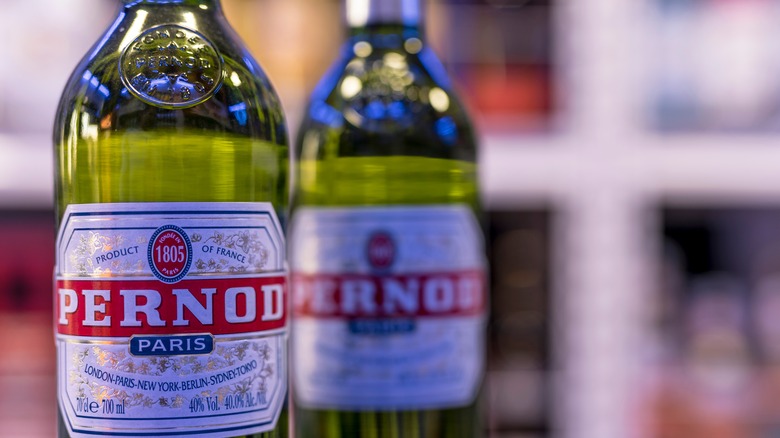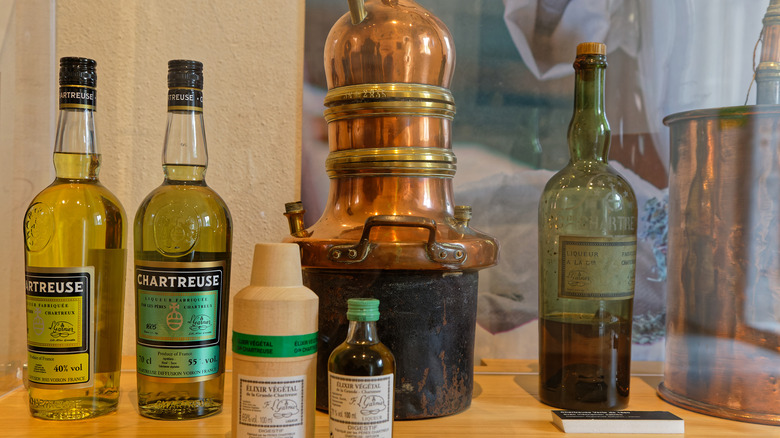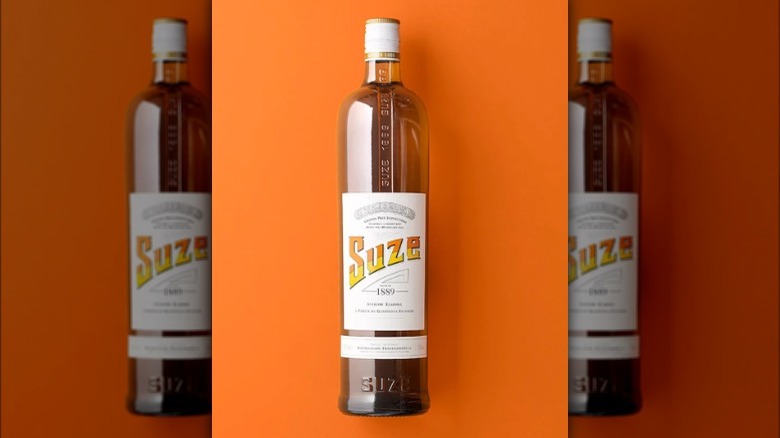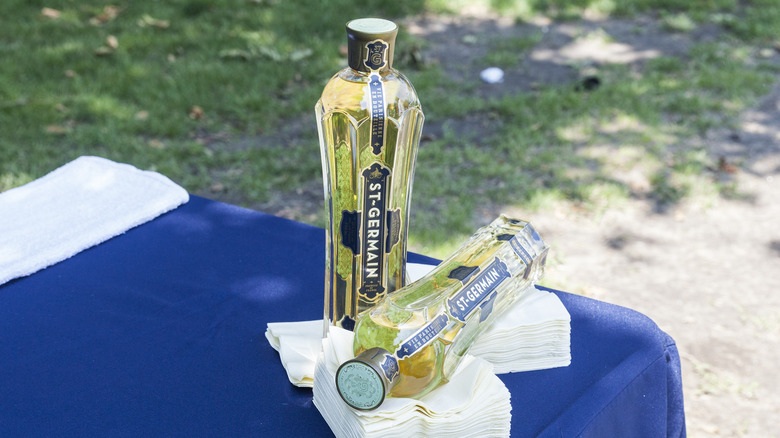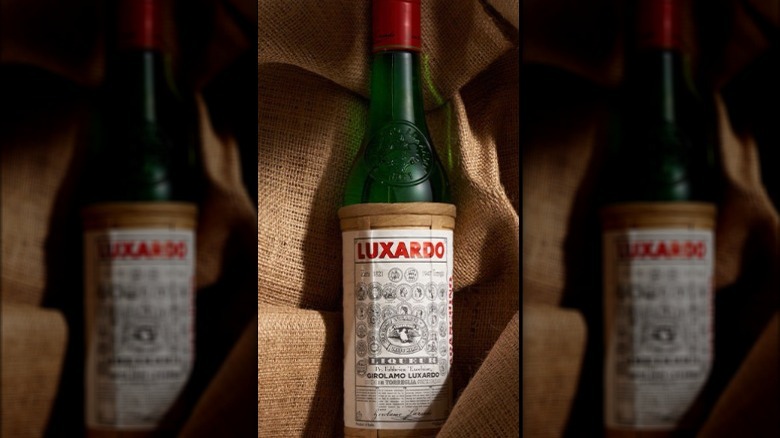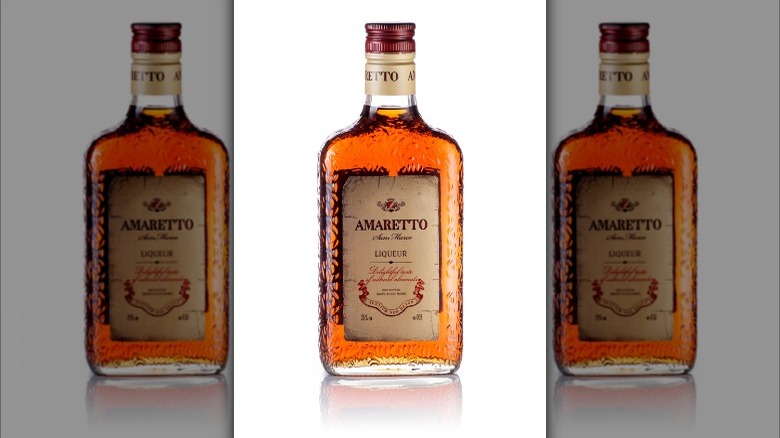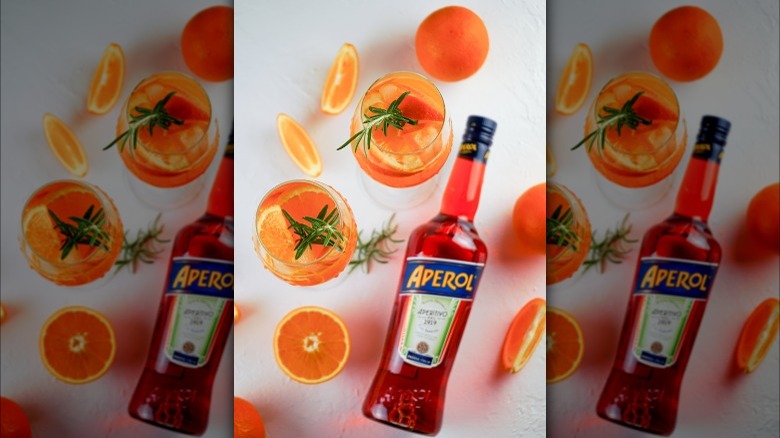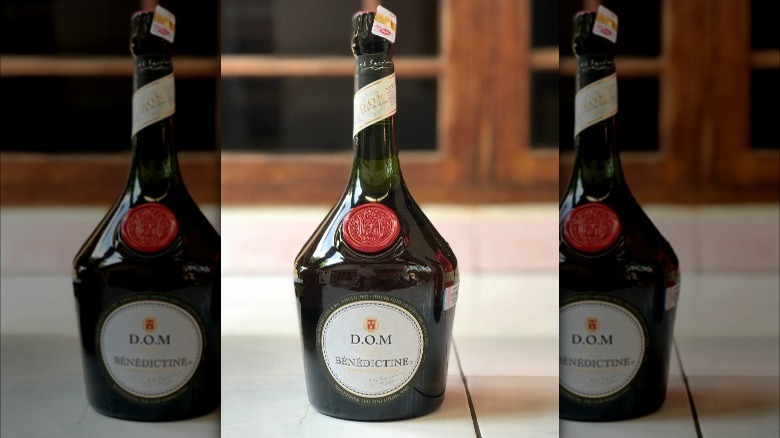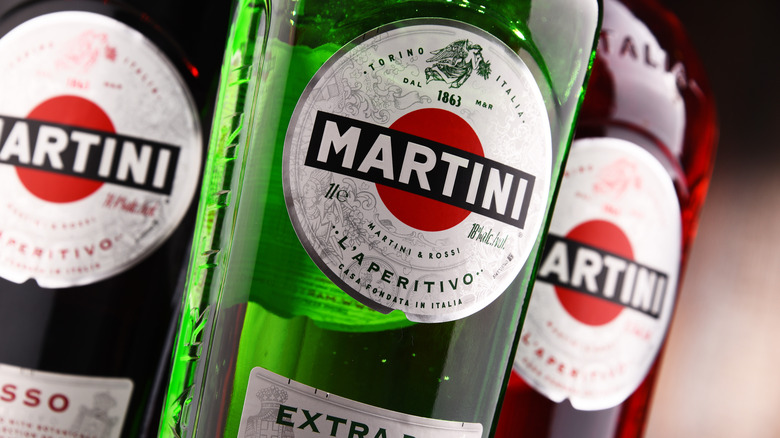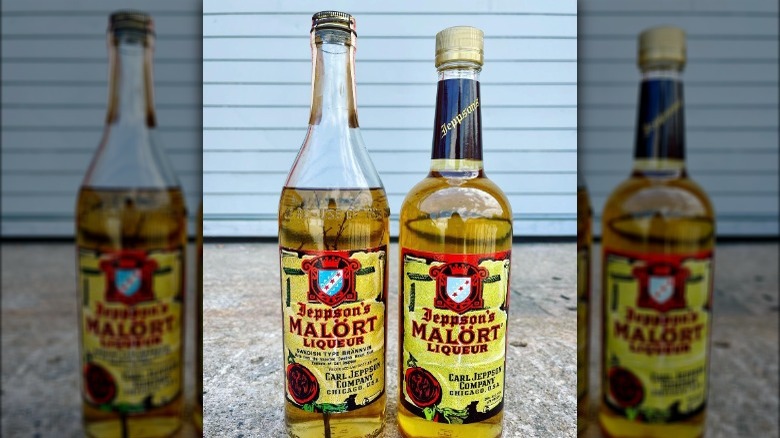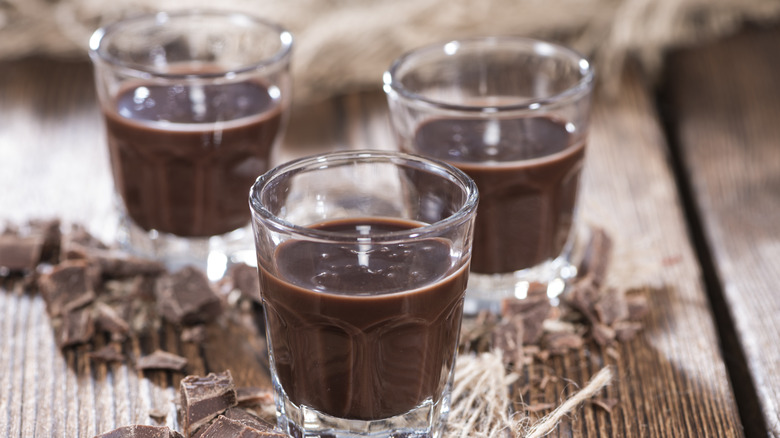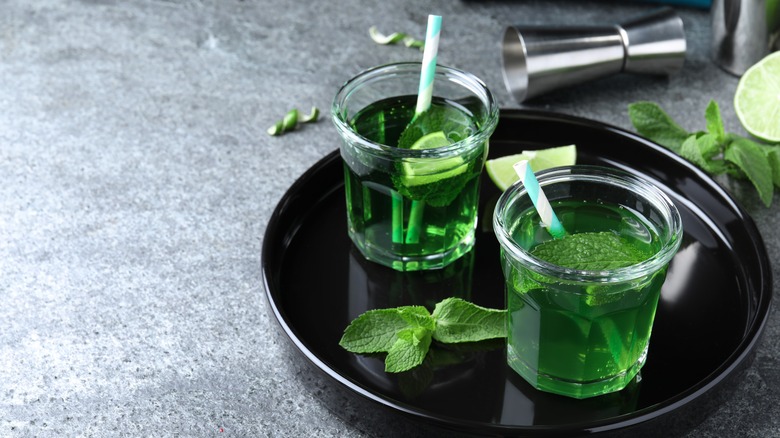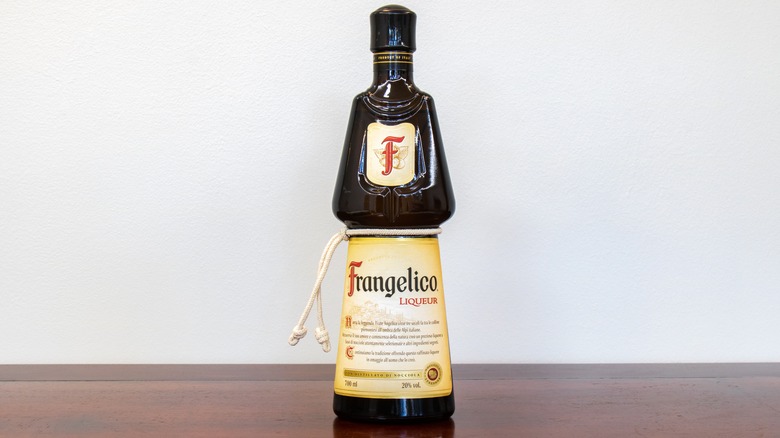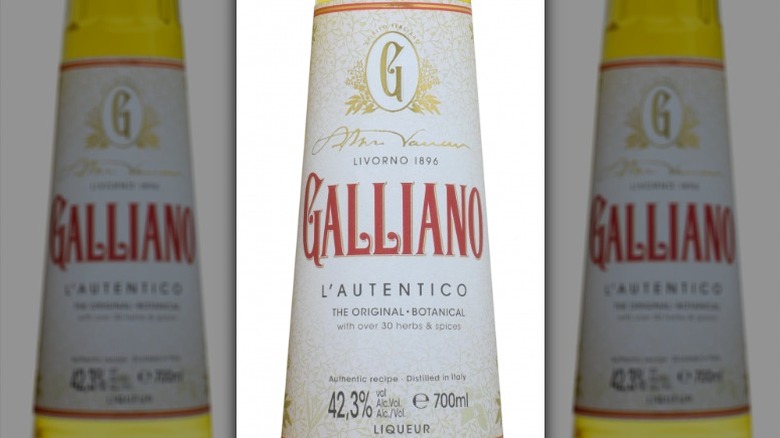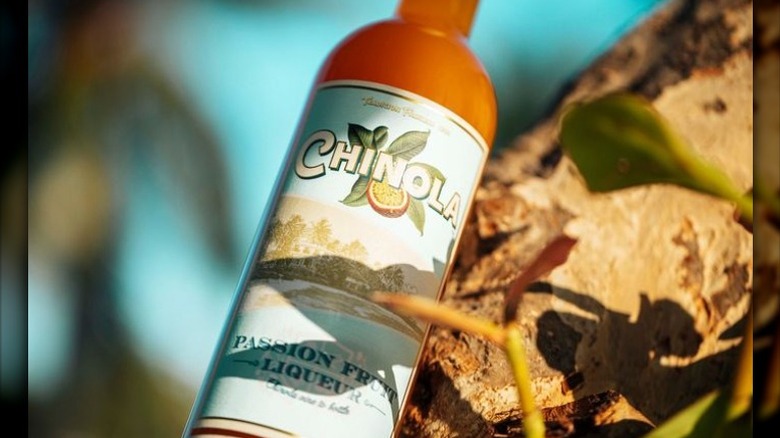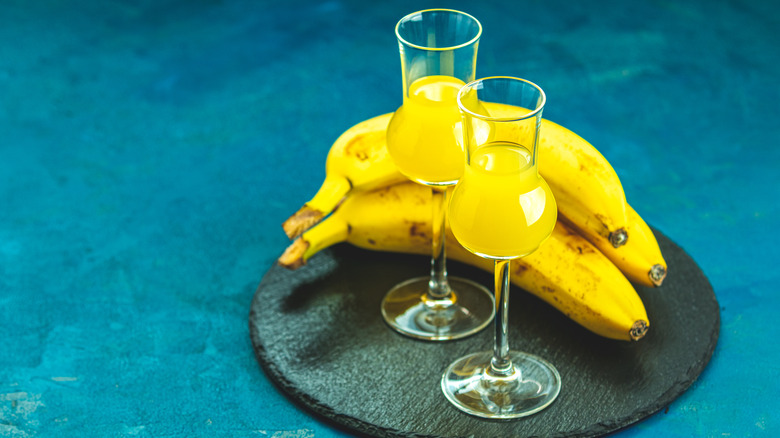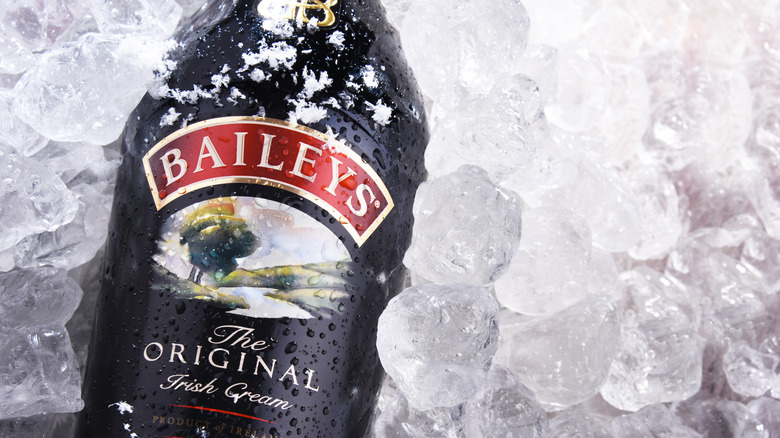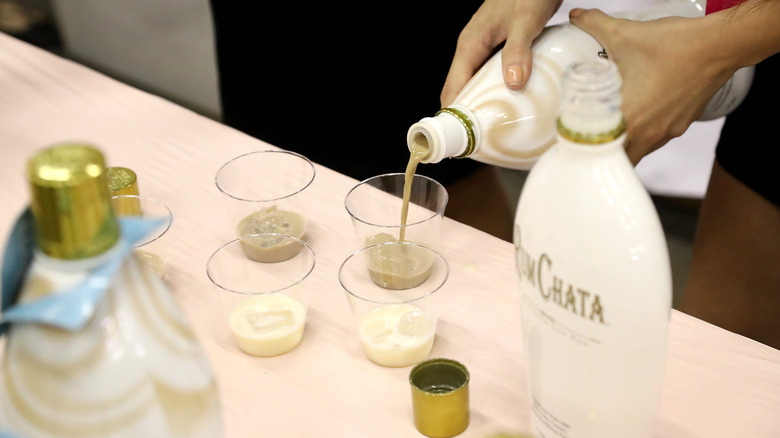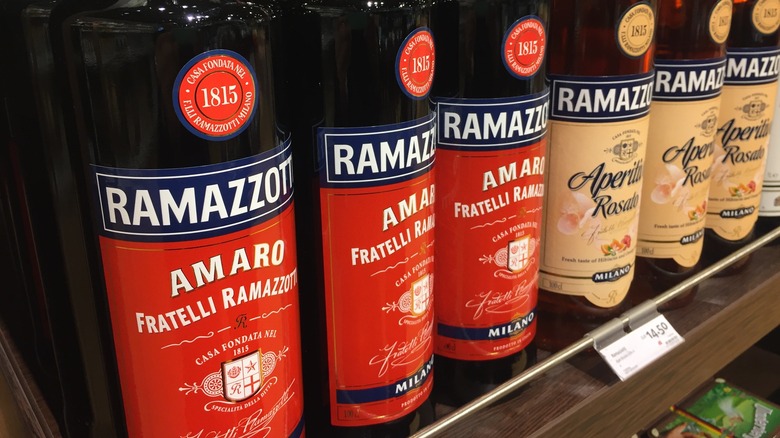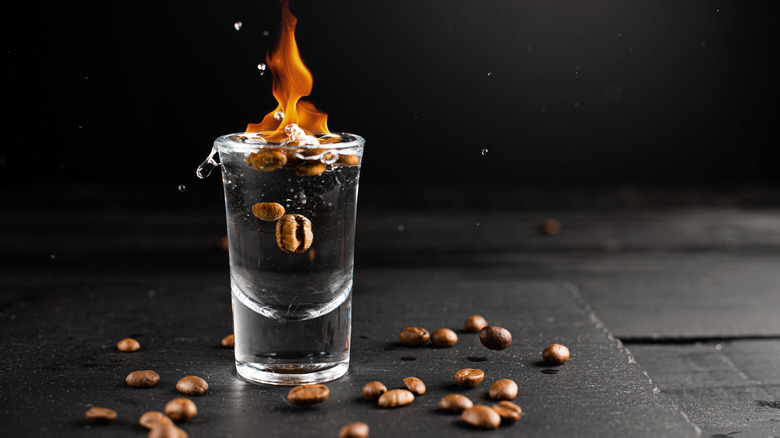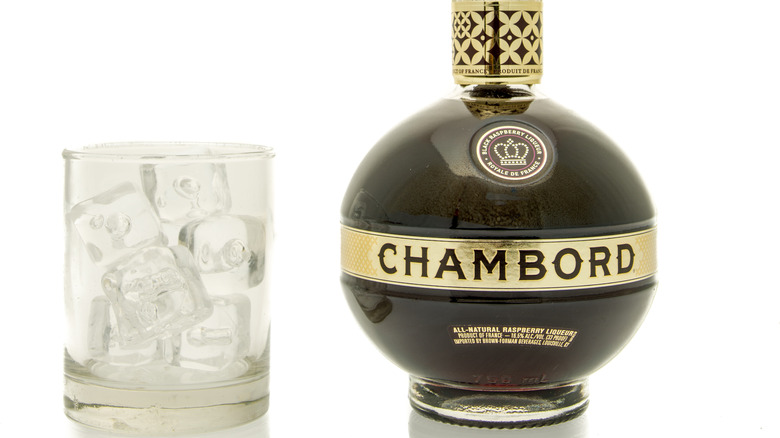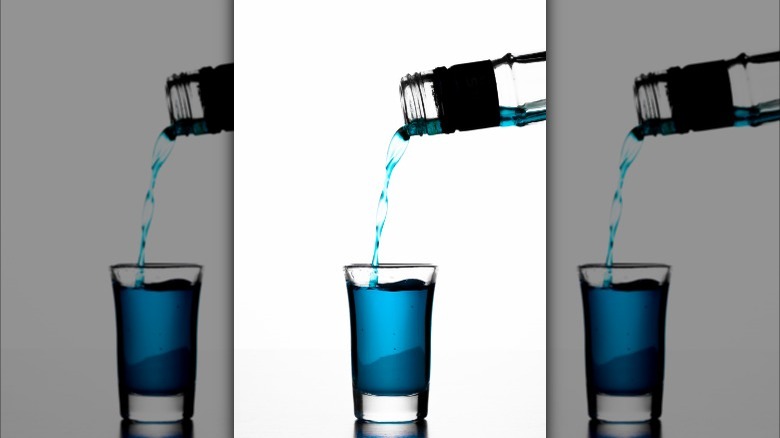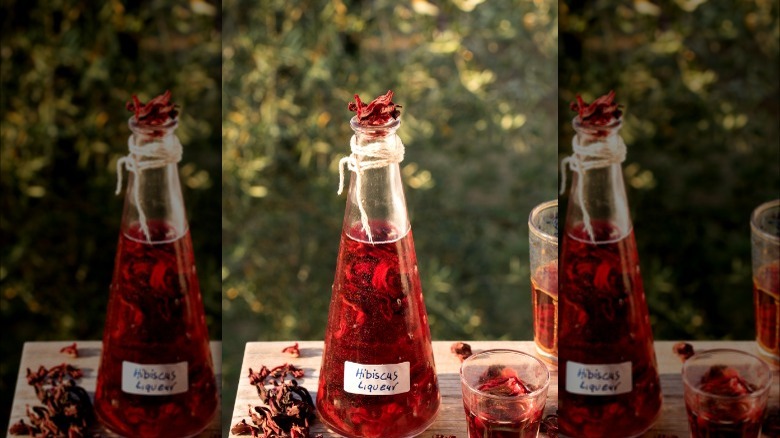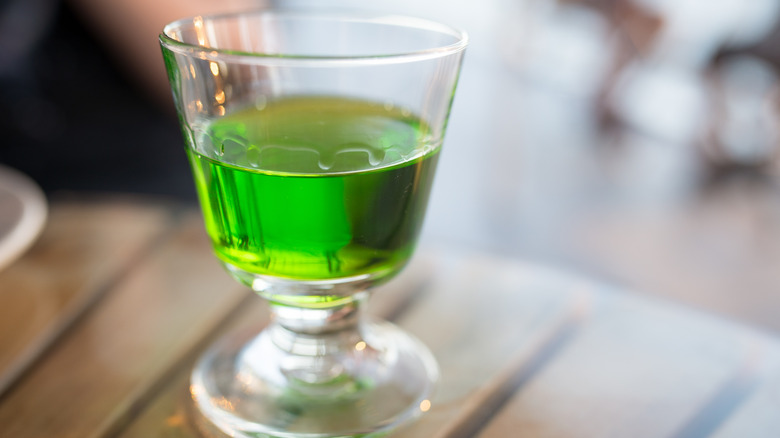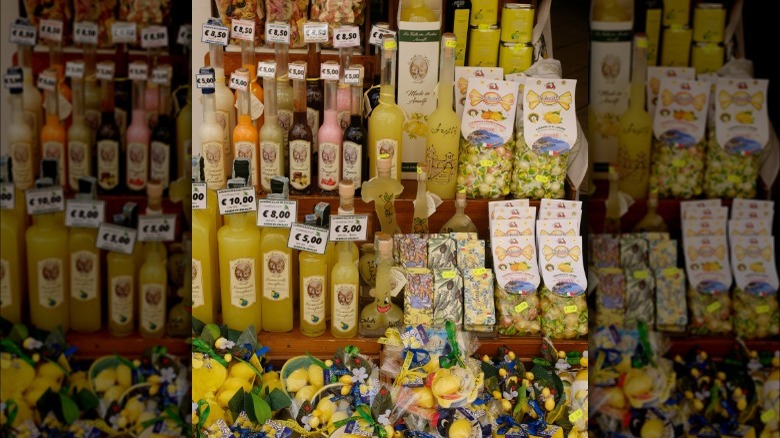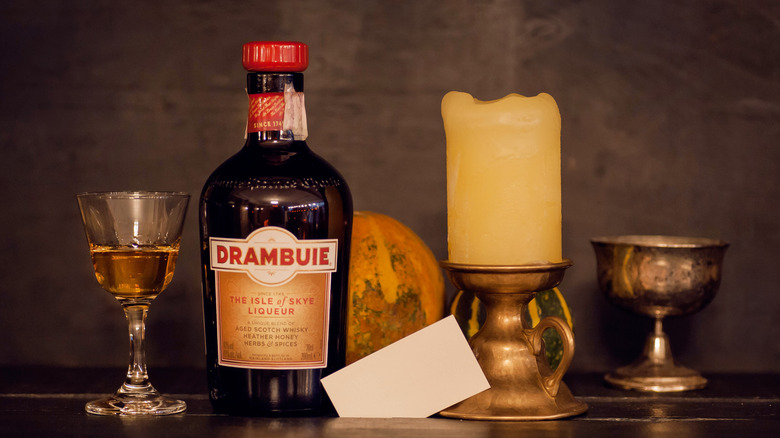15 Best And 15 Worst Liqueurs For Your Home Bar Needs
Straight liquor is only the beginning of the equation for making craft cocktails at home. One often overlooked category is the world of liqueurs. A liqueur is any distilled spirit that is most often used to enhance the flavor of mixed drinks. It isn't a neutral base, like whiskey or vodka. It's usually infused with several ingredients to establish a strong flavor profile.
There are so many spirits and liqueurs on the market that make it even more difficult to stock a home bar. Oftentimes, the average person will only buy liqueurs on occasion, depending on the cocktails they have a taste for. It's not a bad strategy, but it won't help when hosting a party full of people looking for the ingredients to make their preferred cocktail.
Alcohol always feels like a frivolous expense, so it's a bummer to spend money on a bottle that you end up not even liking. To help determine which bottles your home bar needs, we decided to break down 15 of the best and 15 of the worst liqueurs to buy. It's not a foolproof guide for every drinker, as some of the "worst" bottles might be someone's personal favorite. However, it will help determine which bottles you should always have on hand at home and which are worth buying on an as-needed basis.
Best: Triple sec/orange liqueur
If there is only one liqueur on this entire list that you end up keeping in stock, it should be some version of orange liqueur. Orange liqueur is an expansive category that's often used interchangeably with "triple sec." Triple sec is a French version of orange liqueur that is typically dry. Cointreau is one of the most common brands sold at liquor stores today. Other orange liqueurs aren't classified as triple sec, like Grand Marnier, which is essentially a cognac version of orange liqueur that is a mashup of triple sec and Curaçao.
In layman's terms, triple sec is usually referred to as a liqueur that you don't want to drink by itself. Instead, it's a key ingredient for classic cocktails like Cosmopolitans, sidecars, and margaritas. On the other hand, a higher-end bottle like Grand Marnier can be enjoyed on its own as an aperitif or digestif as part of a lengthy meal. Regardless of what bottle you get, the orange liqueur is made from soaking dried orange peels in booze. The result is endlessly useful in even the most unexpected cocktails, like brightening up a one-note mimosa or adding some citrus zest to a batch of sangria.
Worst: Coffee liqueur
We are preemptively anticipating the outrage of including coffee liqueur in the "worst" category of liqueurs, but it's not without solid reasoning. Coffee liqueur has its place in home bars, especially in households where people drink a lot of espresso martinis and White Russians. However, many mainstream versions of coffee liqueur are artificially sweet and syrupy renditions of the spirit that aren't worth the money. It's also a pretty easy ingredient to find a suitable, oftentimes superior, substitute. That even includes making your own coffee-infused liqueur at home.
Coffee should be added to a cocktail to add those complex earthy flavors, not simply add caffeine into a drink. Oftentimes, real espresso or cold brew concentrate will work as a better flavor addition than a run-of-the-mill coffee liqueur, or a combination of cold brew concentrate with a different flavor of liqueur, like chocolate or vanilla. Some distilleries are going above and beyond with their coffee liqueurs by prioritizing the natural and earthy flavor of the coffee beans rather than trying to make it taste like a Starbucks drink. These bottles might be pricy and hard to come by, which is why we don't suggest keeping them on your bar at all times.
Best: Campari
Campari is the red Italian bitter liqueur famous for giving a negroni or a Boulevardier drink its signature deep color. The bitter liqueur is marked by herbal and citrus notes, though the exact recipe has been a secret since it was first invented in 1860. It provides a complexity to any drink it's added to, even a simple Campari spritz or Campari and soda, as well as an intriguing hue. The liqueur can also be useful in recipes for desserts and fruit salads.
Campari is a staple for its versatility. It's similar to Aperol, another bright Italian liqueur, but distinct in flavor. Aperol is a bit sweeter with a secondary hit of citrus, while Campari is bitter with floral and herby notes. Both have their uses on the home bar shelf, but if you're going to buy just one, you can't go wrong with the one-of-a-kind flavor that Campari adds to even the simplest of mixed drinks.
Worst: Pernod
Pernod is a French liqueur made from anise seed, fennel, and other flavoring agents. The brand was originally known for producing absinthe and developed this similarly flavored anise liqueur after the spirit was banned in the 1920s. The 40% ABV spirit has a distinct flavor of licorice, which is why it's not exactly the most necessary liqueur to keep stocked at your home bar. Pernod also stands out because it gets murky when added to liquid, giving cocktails a foggy effect.
Pernod is an acquired taste that isn't the most useful spirit to have on hand unless you're whipping up a Sazerac cocktail. That's to say, those loyal Pernod fans who appreciate the intricate flavors of herbal anise seed shouldn't stop keeping the stuff stocked at home on a regular basis. It's just not necessary to have a bottle on hand if you don't drink it, because the odds are slim that a dinner guest will ask for a Pastis, which is the French way to order a Pernod and water highball.
Best: Chartreuse
Chartreuse is a common liqueur with a mystique for many reasons. For one, the liqueur is an infusion of 130 different herbs and spices and the recipe is a secret guarded by Carthusian monks at the Grande Chartreuse monastery. The green version of the liqueur has been around since 1840 and has a sugar beet spirit base. Naturally occurring chlorophyll gives the 55% ABV green version its eye-catching color, but the flavors are even more striking. Green Chartreuse is sometimes described as having a medicinal taste, but it's marked by herbaceous notes of pepper, mint, and pine. If that wasn't intriguing enough, green Chartreuse also takes on different textures and flavor characteristics whether it's shaken or stirred in a classic drink like a Last Word gin cocktail.
Yellow Chartreuse, which has a grape spirit base, gets its bold color from the saffron in its grind. The yellow version also uses 130 different kinds of plants and herbs, but it's a bit sweeter and spicier than the peppery green version. It's also a little less boozy than the green liqueur, containing 43% ABV. The process for making both versions is in-depth and comes with a rich history, but both versions are worth trying at least once. If you have to pick just one, you can't go wrong with classic green Chartreuse to impress your guests with impromptu Bijou cocktails.
Worst: Suze
Suze is one of those liqueurs you don't need to keep at home. The French gentian liqueur is the kind of drink you can enjoy on occasion at a nice bar out to get your fix. Gentian is a wild flowering plant native to the Alps that's used in other liqueurs, like vermouth or amaro, mainly for its bitter qualities. Suze was invented as an aperitif in 1885 and isn't very boozy at 15% ABV. Making Suze is a labor of love as the gentian plants take a minimum of 10 years to reach maturity. The root is macerated with grape-neutral alcohol and aged to create a bitter flavor with a slightly floral taste.
Suze and gentian liqueurs can result in amazing cocktails, like a white negroni. However, they're just not necessary to hunt down to complete your home bar. Suze can be difficult to get your hands on, as well as other gentian liqueurs, which is why it's much more of a treat to stumble across a bottle behind a bar and have an experienced bartender craft you a cocktail.
Best: St. Germain
Another French liqueur that has more of a modern-day history is the ever-popular St. Germain. The elderflower liqueur unveiled itself to the world in 2007, igniting a new era of cocktail culture. The 20% ABV liqueur is made with fresh elderflowers that are hand-picked once a year. The fresh elderflowers are macerated in eau-de-vie, or grape-based alcohol, to extract that floral and slightly fruity flavor. St. Germain's flavor is distinctly elderflower, but for those unfamiliar with the profile, there are stand-out notes of pear, honeysuckle, and citrus. The pollen from the flowers is what gives this versatile liqueur its iconic golden hue.
St. Germain is basically a must-stock at any bar these days. It can anchor a simple spritz recipe or add something different to basic drinks like margaritas and gin and tonics. You can't go wrong keeping a bottle on the bar to get creative with or to add to a humble mimosa just for an added floral kick. In fact. St. Germain is often referred to as "bartender's ketchup" because it mixes so well with everything, so it's never a bad idea to buy a bottle without any clear plans for it.
Worst: Sloe gin
Most people who haven't spent time in the U.K. likely aren't too familiar with real sloe gin. In the U.S., sloe gin is technically an ingredient in some cocktails like the Alabama Slammer, but it's usually an imitation version that's more similar to grenadine than the real stuff. Sloe gin is made from dark and small wild berries grown around Northern Europe. The berries aren't that tasty to eat due to their tart and harsh flavor, but they do make for good liqueur making. In the U.K., sloe gin is usually enjoyed as a wintertime digestif after sloe berries reach their peak ripeness in the fall. It's made with gin but is lighter in ABV, darker in color, and way less reliant on juniper as a flavor. The taste is similar to sour cherries, but it's way more complex than that.
Sloe gin is most commonly used in drinks like a Charlie Chaplin or a sloe gin fizz. Because it's not that widely loved as an ingredient, it's not worth seeking out for your bar. Good sloe gin is hard to source and not the most crowd-pleasing liqueur you can keep stocked. The bottle will likely cost you a lot and end up taking up unnecessary space on your bar, which is why we suggest skipping this stuff.
Best: Luxardo Maraschino
Maraschino liqueur could have been an alternate title to this suggestion, but Luxardo is the tried-and-true original, so it's a no-brainer bottle to keep on your bar. Luxardo has been using the same recipe since it was created in Italy in 1821. Luxardo takes marasca cherries that are harvested at the end of each summer and infuses them with booze. Marasca cherries are small, firm, and slightly sour fruits that are native to the Dalmatian Coast of Croatia. It's why maraschino liqueur is nothing like grenadine or even jarred Maraschino dessert cherries. The flavor is robust with cherry flavor with complementary notes of almond and vanilla to make any cocktail taste like dessert.
The rich and steady history of Luxardo liqueur's role on the bar counter is enough of a reason to keep it stocked. Additionally, the Maraschino liqueur is a key ingredient in cocktails like the Hemingway daiquiri, a classic Martinez, or an Aviation drink. It also is tasty drizzled over fruits or ice cream, so you won't have to worry about trying to come up with ways to finish a bottle.
Worst: Amaretto
An Italian liqueur you can skip, on the other hand, is amaretto. It's an almond-flavored liqueur typically made out of almonds and/or the pits of apricots or peaches. There's plenty of sugar inside to make it sweet, which can be the downfall of the liqueur; it's hard to find a great bottle of amaretto that isn't overwhelmingly sweet. In Italian, amaretto translates to "a little bitter," so a good bottle should have balanced bitterness with sweet, nutty flavors.
Usually, amaretto is used in drinks like an amaretto sour or in Italian desserts like tiramisu, but again, only if it's a good bottle. One of the most popular brands of amaretto is Disaronno, which has been around for centuries and is easy to find when you need it. Aside from that, it can be hard to source and limiting to use, so it's not necessary to keep amaretto stocked at all times in case of emergencies.
Best: Aperol
It might be redundant if you aren't someone who orders a spritz as their drink of choice to stock both Aperol and Campari at all times, but each bottle has its place. Aperol is another Italian liqueur that is known for its bittersweet orange flavor. The 11% ABV liqueur has been around since 1919. The spirit is best known for being the backbone of an Aperol spritz, which is made using the liqueur, Prosecco, and club soda. In fact, the brand really can thank the mainstream popularization of the spritz in the 1950s for making it a must-stock bottle at bars far outside of Northern Italy.
Unlike Campari's herbal bitterness, Aperol has a distinct citrusy sweetness to it. It's what makes it a staple in other cocktails like a Paper Plane or a Division Bell. It really comes down to flavor preference whether Aperol or Campari is the Italian aperitif for you, but you can't go wrong with buying a bottle of either. If you don't like the taste of one, odds are it won't be hard to find a friend who fancies a sunset-colored spritz.
Worst: Benedictine
D.O.M. Benedictine is another liqueur with a rich history that some people love. It's just not completely necessary to always have a bottle in your liquor cabinet at all times. Benedictine has been around since 1510 and features a blend of 27 plants and herbs infused with a neutral spirit. The recipe was created by a French monk, originally for medicinal use, and has been passed down for generations.
The process for creating Benedictine's signature recipe is labor-intensive, but the result is a flavorful liqueur with a lot of notes going on. The main flavor notes include honey, pine, almond, and citrus, but that's only scratching the surface. It's commonly used as an ingredient in a simple tonic drink or in something more involved like a Singapore Sling. It's a great liqueur that every drinking enthusiast should try at least once, but because of its limited uses, we wouldn't suggest regularly buying a bottle unless it's your all-time favorite.
Best: Vermouth (Sweet and dry)
Vermouth is technically fortified wine rather than a traditional liqueur, but it's the ultimate supporting player in so many cocktails that it's a must-stock at any bar. There are many expressions of vermouth hailing from Italy and France and usually containing 15%-18% ABV. The three main types of vermouth are sweet Italian red/Rosso, dry, and blanc/Bianco. Each type pairs better with different spirit bases and ingredients, but no vermouth is meant to be drunk straight up.
Vermouth is made by flavoring wine with herbs and spices to add flavor and aroma and then adding a neutral-tasting spirit to boost the alcohol content. There are many brands and varieties of vermouth on the market and each bottle is different, so it's worth exploring. A good starting place would be Martini & Rossi, an Italian spirits brand that's been making vermouth since the 1860s and sells several expressions of the spirit. Essentially, the possibilities are endless for what vermouths you can add to martinis, Manhattans, and beyond to experiment with flavor.
Worst: Jeppson's Malört
For those folks who haven't spent much time in Chicago, Jeppson's Malört might be a completely foreign spirit to you. Those familiar with the peculiar liqueur probably know immediately why we don't think it's a bottle everyone should stock at their home bar. Jeppson's Malört is a wormwood liqueur that tastes similar to absinthe, but it's so bitter that the flavor lingers indefinitely on your palate. The liqueur has been around since 1933, even though a version of it was sold as a medicinal product during Prohibition. Some people believe that Jeppson's Malört is a hangover cure or a digestive agent, but most people drink it for the novelty.
Chicagoans relish making out-of-towners shoot Jeppson's Malört at a bar and watching them gag at the bitterness. There's a cult fandom around the liqueur for being so bad that it's good, and the brand has leaned in on the distaste for the product in its marketing. Jeppson's Malört is the kind of liqueur you take a shot of for a dare, not to keep stocked at home for a moment's notice—that is, unless you're a Chicagoan who loves to prank people into drinking the spirit of your hometown.
Best: Creme de cacao
It's never a bad idea to have a few quick ingredients on hand for a spontaneous dessert cocktail, which is why creme de cacao is a good bottle to keep in stock at home. Creme de cacao is a sweet chocolate liqueur that, contrary to popular belief, typically contains no dairy. It's a sugary liqueur that is rich in cocoa and vanilla flavors that usually has a sugar beet distillate as its base spirit.
Creme de cacao, or chocolate liqueur, is commonly used in tasty cocktails like a chocolate martini or a Brandy Alexander, but also tastes delicious when poured over ice cream. Many brands make different iterations of creme de cacao, including Patron, Godiva, and Mozart, which are all good places to look for a specific bottle to match your flavor profile and budget. It's not the most necessary liqueur to make staple cocktails at home, but it is a good ingredient to have when a special treat is in order.
Worst: Creme de menthe
Similarly to creme de cacao, creme de menthe is a sugary liqueur that usually doesn't contain dairy. Unlike the previous best liqueur, creme de menthe is one of those bottles you don't always have to keep in your liquor cabinet just in case. The bright-green liqueur can be a little off-putting, as can the extremely sweet flavor. Creme de menthe is really only used in throwback cocktails like the Grasshopper, which isn't exactly the most common bar order to hear in the 2020s. Outside of that retro drink, you will have to get pretty creative to think of inventive cocktail ideas to use up the rest of the bottle.
Creme de menthe and mint-flavored spirits in general aren't the most favorable flavor profile for cocktails. It seems more fitting in a dessert or a dessert cocktail like a Grasshopper or spiked hot chocolate. It's one of those spirits you should buy when the craving hits, not because you feel obligated to have a bottle behind your home bar.
Best: Frangelico
Frangelico is an Italian hazelnut liqueur that has a flavor profile like no other spirit. The 20% ABV liqueur is made in the Piedmont Hills in Northern Italy, a region known for its sweet and small hazelnuts. Piedmont hazelnuts are ideal for desserts, which is what makes this liqueur feel like a liquid treat. The golden liqueur also contains notes of coffee, cocoa, and vanilla, and the drink has an undeniably rich texture that's satisfying to sip straight over ice.
Frangelico also has its place in cocktails, from a remixed Old Fashioned to a chocolate cake shot. It's even great to spike a cup of coffee with a little boozy hazelnut flavor that also adds a bit of sugar. If that's not enough reason, Frangelico's monk-shaped bottle and the lore of hazelnut liqueur made by Italian monks in the region make this bottle undoubtedly cool enough to display on your liquor shelf.
Worst: Galliano L'Authentico
Another Italian liqueur worth skipping on your liquor store run is the botanical Galliano L'Authentico, which has been around since the 1890s. It's hard to classify the flavors of Galliano L'Authentico succinctly, but the stand-out flavor notes are anise and peppermint. As previously mentioned, both of those flavors aren't the most popular among modern-day drinkers. The spirit goes in and out of style at bars, which makes it a better liqueur to enjoy out rather than at home on a regular basis.
Galliano L'Authentico is created with a secret and complex recipe featuring more than 30 herbs and spices to get its flavor. The taste is bold, but almost too overwhelming to make it a crowd-pleasing drink. A bottle can also be pricy and upward of $40 as of March 2023, so it's not worth buying unless you have a particular affinity for the herbaceous Italian liqueur.
Best: Chinola
Chinola passion fruit liqueur might be one of the newest bottles on the market, making its U.S. national debut in 2021, but it's already become a modern-day classic. Chinola is another word for passion fruit in Spanish, and the brand is dedicated to delivering a liqueur that embodies the spirit of its Dominican roots. Chinola is a 21% ABV spirit that has a natural passion fruit flavor that is the star of the flavor show. It tastes like a fresh-squeezed juice with plenty of acidic tartness and a pleasant orange hue.
Chinola is good in everything, which is why we recommend it on any average bar cart. It can elevate humble mimosas and mojitos into a Tiki drink made for the beach. It also gives the tropical vibe to any cocktail without requiring the bartender to muddle any fresh fruit or whip out a juicer to achieve a similar flavor.
Worst: Banana liqueur
Unless you're bananas about bananas, it's not necessary to keep a bottle of banana liqueur at home. Banana liqueur is a dessert-like spirit that's also referred to as creme de banane in French. A neutral alcohol, usually a sugar beet distillate, is infused with fresh banana extract and sugar to get the exact flavor. It's another liqueur you can make at home, but it's a bit more labor-intensive than some of the others.
Banana liqueur is most often used in Tiki rum-based drinks or any cocktail you'd want to drink while sitting by the ocean. The issue is that banana cocktails are either really amazing or extremely disappointing. If you don't find craft banana liqueur, the low-cost options can oftentimes be syrupy and overly sweet. A bar that has perfected a banana daiquiri or other banana liqueur-fueled drink likely is the best of the best, so it's one of those liqueurs you should enjoy in the atmosphere of a high-class bar or Tiki joint.
Best: Irish cream
It's never a bad idea to keep a bottle of Bailey's Irish Cream on hand whenever the mood strikes for an Irish coffee or a boozy dessert. Irish cream like Bailey's, which has plenty of interesting history and lore behind the brand, is made from Irish whiskey, cream made from Irish cows, and hints of chocolate and vanilla. It's not very boozy at 17% ABV a bottle, which is what makes it a perfect addition to a plain cup of coffee or a scoop of vanilla ice cream.
Irish cream is useful for other cocktails as well, like dessert martinis or decadent mudslide drinks. Other brands, like Five Farms Irish Cream, Kerrygold, and even Costco's Kirkland Signature brand, are all worth trying, but Bailey's is the real deal that deserves a spot on every home bar. It especially comes in handy when you have a guest over who doesn't like strong cocktails, but would like to sip on something a little special.
Worst: Rumchata
A cream-based liqueur you can skip at the liquor store is Rumchata. Rumchata is another modern-day spirit; it was invented in 2009 and is made in Wisconsin. The idea is to combine rum with dairy cream and spices inspired by Mexican horchata. The 13.75% ABV spirit contains Caribbean rum, fresh cream, and flavors of cinnamon and vanilla. The brand makes other flavors like peppermint and limon, but the original is the most common. It's a drink that has warm flavors even though it's enjoyed over ice, but it is far from the most versatile liqueur on the list.
Rumchata is one of those spirits many bartenders consider to be overrated. It's meant to be enjoyed on the rocks or infused in shots, but it's a novelty that doesn't have the staying power on the bar shelf as some of the other liqueurs on the list. It's not that a boozy horchata drink can't taste delicious, but it's probably not best executed straight out of the liqueur bottle.
Best: Amaro
OK, we can also expect some heat from including Amaro on the list, as it's a category of liqueur that's pretty expansive. Amari describes a wide range of bittersweet liqueurs from Italy. Yes, Campari and Aperol are technically Amari, but we decided that the category was so important, it was worth a separate shout-out. Several different sub-categories of Amari are usually classified by the alcohol base of the spirit or the flavor additives used in each recipe.
Amaro is an important class of liqueur to keep on your home bar because it's endlessly useful for aperitivos and beyond. Depending on the blend and bottle, it can be featured in a spritz, craft cocktails, or enjoyed on its own. Outside of the two bottles we mentioned, other Amari worth exploring include Amaro Lucano, Montenegro, and Cynar. Then, you can determine based on flavor preference which bottle should get a permanent spot at your home bar.
Worst: Sambuca
Most people who are familiar with sambuca might know it as a licorice-flavored spirit that sometimes is served with a flaming coffee bean on top. Sambuca is a boozy anise-flavored liqueur that is most often used for shots as a digestif after a meal. Sambuca is also served either mixed with coffee or alongside an espresso, which is how the coffee bean comes into play. Some sambuca shots are served with a coffee bean to add flavor to the spirit. If it's on fire, the idea is to "roast" the coffee bean to open up those intense flavors.
We don't suggest keeping a bottle of sambuca at home at all times because it's a novelty. It's more fun to drink a round of sambuca shots with friends after a nice meal at an Italian restaurant than while watching TV at home. There are a few innovative cocktails you can try to make with the stuff, but it hasn't gained that much traction. Therefore, other anise-flavored liqueurs are more useful to keep on your bar, if that's a flavor profile you enjoy drinking regularly.
Best: Chambord
Another fruity liqueur worth keeping on your bar is Chambord. Aside from the French liqueur's regal appearance, the black raspberry spirit is a simple way to add zest to even the most basic cocktails. Chambord is made with blackberries, raspberries, and blackcurrants for a well-rounded berry flavor. The 16% ABV spirit also includes XO cognac, Madagascar vanilla, citrus peels, and honey to balance out the flavor. It tastes like the essence of a fresh berry pie in the summer, so you can just imagine how well that translates to cocktails.
Chambord can be a fun swap for triple sec in drinks like margaritas or can add sweetness to otherwise basic Old Fashioneds. It provides an authentic berry flavor without requiring you to muddle any fresh fruit into a cocktail shaker. Chambord also makes for a great addition to ice cream parfaits and other desserts for an adults-only twist.
Worst: Blue Curaçao
Technically, Curaçao is just another version of orange liqueur. It's made from the peels of laraha fruits, a bitter citrus fruit from the Caribbean island of Curaçao, which aren't eaten but used to make liqueur and essential oils. Blue Curaçao is just that same orange liqueur, but blue. The blue isn't a flavor; it's just artificially added color for dramatic effect. It's the surefire way to make cocktails like the Blue Lagoon have that signature striking color.
Because Blue Curaçao is more for fun than it is practical, there's no need to shell out money to keep it at your bar. Some people even think that blue Curaçao tastes more like candy than a fresh orange liqueur, so it can have a negative effect on some cocktails it's mixed into, depending on the bottle. It's alright if you and your friends only ever get to enjoy bright blue drinks on a night out because there's no need for them to be a regular dinner nightcap.
Best: Hibiscus liqueur
Hibiscus liqueur might not be a classic bar staple, but it can be a fun addition to so many drinks to add a hint of floral brightness. Hibiscus flavor has garnered a lot of popularity in the U.S. in the 2020s in both food and drink. It's favorable for its fruity and floral flavor, plus its hyperpigmentation that turns any drink into an eye-catching pink color.
Hibiscus liqueur is a great addition to sparkling wine or tequila, as the flavors blend almost too perfectly together. It can also be an easy ingredient to add to basic gin and rum drinks. Hibiscus liqueur has almost a jam-like flavor, especially bottles from Greenbar Distillery, which distills blackberries in the mix. If you don't want to shell out the money to buy a bottle, hibiscus liqueur is another easy spirit to make at home. All you will need is some neutral alcohol, dried hibiscus blossoms, and a few aromatics to achieve the trendy flavor enhancer.
Worst: Melon liqueur
One fruit liqueur you don't necessarily need to keep on your bar at all times is a melon liqueur. A popular brand is Midori, a bright-green spirit made out of Japanese muskmelons. Similarly to blue Curaçao, it seems like most of the fun of melon liqueur is in its bright color. The alien green hue will make anyone do a double-take at your cocktail, which is why it's better to enjoy it in a bar setting to get heads turning.
Melon liqueur often ends up tasting like artificial melons, regardless of how much fresh fruit is incorporated into the product. It's rare to find a bottle that tastes like biting into a perfectly ripe piece of cantaloupe or honeydew, which is why it isn't worth the hassle. It's another spirit that can be limiting when it comes to cocktail crafting. Outside of a riff on a melon martini, it's far from the most multifaceted liqueur you can keep on your bar cart.
Best: Limoncello
The final liqueur to complete your overstocked home bar is limoncello. The Italian digestif embodies the flavor of sweet Italian lemons that makes for the perfect ending to a delicious meal. Most limoncello is made using high-proof grain alcohol, like vodka, soaked in lemons and simple syrup. It's so easy that many people make it at home, but it's also common to see premade bottles sold at the liquor store. Some popular brands like Fabrizia and Don Ciccio & Figli are worth exploring in the spirit genre.
Limoncello is usually enjoyed at the end of a meal by itself or in a martini. It can also make for a great ingredient in dessert, especially when you soak cakes and cookies in the spirit. It's so useful and crowd-pleasing that it's hard to not find countless ways to use up a bottle that's taking up space in your liquor cabinet, so you can't go wrong having some on hand at all times.
Worst: Drambuie
The last liqueur worth skipping on your next stock-up trip to the liquor store is Drambuie. Drambuie is a whiskey liqueur made out of aged Scotch, Scottish heather honey, and plenty of herbs and spices for flavor. The spirit has roots among the 18th-century U.K. royals, making it a popular drink for those Northern Europeans who appreciate its history. However, outside of on the rocks or in a Rusty Nail cocktail, it's just not that useful.
Drambuie can also be expensive, costing upward of $40 a bottle as of March 2023. The flavor is delicious and full-bodied, so Scotch drinkers can appreciate it. However, it's just not that necessary of a flavor profile to keep at your home bar at all times. There are plenty of other options worth exploring unless Drambuie happens to be one of your go-to drinks. As with all of our recommendations, to each their own.
